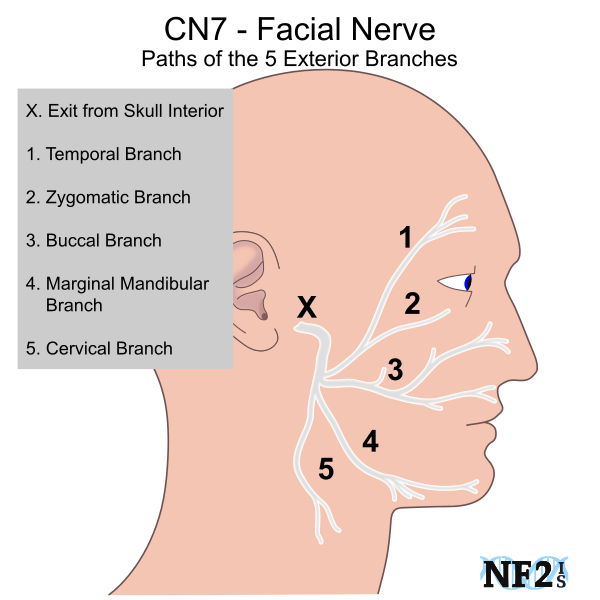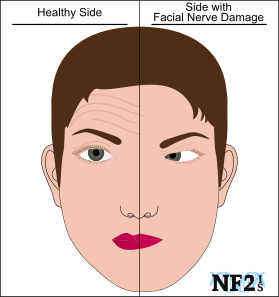Home > NF2 Facts & Information > Damage - Tumors and Schwann Cells > Cranial Nerves >
CN7 Facial Nerve Damage
Facial Palsy

Index
- Highlights
- Reasons for Facial Nerve Damage
- Facial Nerve Information
- Facial Nerve Damage Issues
- Natural Healing Time
- Natural Healing
- Physical Therapy
- Acupuncture
- Food, Supplements,
and Medication - Medical Treatment
Options - Nerve Grafting
- Free Muscle Transplant
- Dry Eyes and
Excessive Tearing Options - BOTOX
- Common Questions
- Definitions
- Sources
1. Highlights
- It is common for individuals with Schwannomatosis - NF2 to develop facial nerve damage either during natural tumor growth of vestibular schwannoma (VS) or treatment of VS.
- The facial nerve branches to five nerves and goes to different areas of the whole face.
- Facial nerve damage is not a cosmetic issue; it can result in problems with speech, eating, and vision.
- Some of the facial nerve will heal on its own.
- While there are surgical options, physical therapists recommend physical therapy first..
- Surgical options have limits.
- Stroke and Seizures: Individuals with facial nerve damage should know to inform doctors facial paralysis is from nerve damage. Seizures are more likely issues for individuals with NF2 or other reasons for facial nerve damage, not strokes, even if both are possible.
- Different from either Ramsay Hunt Syndrome (RHS) and Bells Palsy
2. Reasons for Facial Nerve Damage
Damage to the Cranial Nerve 7 - Facial Nerve can happen as a result of:
- Vestibular Schwannoma
- CN7 damage and Cranial Nerve Schwannoma
- Möbius Syndrome
- Bell's Palsy
Vestibular Schwannoma
The hallmark issue of Neurofibromatosis Type 2 (NF2) is the bilateral growth of schwannoma bilaterally on cranial nerve 8 (CN8), the nerve in the brain vestibulocochlear nerve. CN8 has two branches of different function the cochlear (auditory) nerve branch for hearing and the vestibular nerve branch for balance. These tumors are either called acoustic neuroma (AN) or vestibular schwannoma (VS).
The growth of a VS does not guarantee damage to the cranial nerve 7 the facial nerve but is a possible risk. Reasons a VS could result in damage to cranial nerve 7 (CN7) the facial nerve:
- Proximity. CN7 leaves the brainstem close to CN8. (see page graphics) The growth of a tumor on CN8 will cause pressure on CN7.
- Surgery. A surgical method, the Mid Fossa Approach. The approach to removing a VS for hearing preservation requires cutting the facial nerve.
- Radiation Treatment. Radiation treatments to cause tumor death of a VS can also kill the function of nerves and other components in the surrounding area.
- Radiation Treatment. Radiation treatments to cause tumor death of a VS can damage the facial nerve when the tumor commonly swells within the first month before shrinks with tumor death.
CN7 damage and Cranial Nerve Schwannoma[Rare cranial nerve schwannomas, 2018]
Facial nerve damage, damage to CN7, is not only the possible result of a tumor or treatment of a tumor on CN8 but could also be the result of tumor growth on CN7.
The hallmark location of NF2 schwannoma growth is bilaterally along CN8. Other common locations or schwannoma growth in individuals with NF2 include:
- (CN7) facial nerve
- (CN5) trigeminal nerve
- (CN3) oculomotor nerve
- (CN4) trochlear nerve
- (CN6) abducens nerve
- (CN9) glossopharyngeal nerve
- (CN10) vagal nerve
- (CN11) spinal accessory nerve
- (CN12) hypoglossal nerve
3. Facial Nerve Information
Inside the Skull

Vestibular Schwannoma, are Schwannoma tumors along Cranial Nerve 8, are an issue that develops in many individuals with NF2. Cranial Nerve 8 travels a similar path as Cranial Nerve 7, the Facial Nerve, extending out of the brainstem right next to each other. The purpose of CN8 is hearing and balance. Individuals who develop Vestibular Schwannoma commonly develop damage to the Facial Nerve; also known as Facial Nerve damage, or Facial Paralysis.
Learn more about Hearing and Balance: CN8 - Vestibulocochlear Nerve.
Major Nerve Branches Outside of the Skull


The facial nerve branches off to smaller nerves and muscles that go to 5 different parts of the face. Therefore, when the nerve is damaged those smaller veins are not supplied with enough blood for circulation which is necessary for muscles in the different areas of the face to move. Each nerve branch affects the movement of different muscles.
The image to the right and the description shows how far the Facial Nerve reaches.
- Temporal Branch
- Zygomatic Branch
- Buccal Branch
- Marginal Mandibular Branch
- Cervical Branch
- 1. Temporal Branch - (Frontal Branch). This Nerve Branch affects the muscles in the Forehead.
- 2. Zygomatic Branch - (Malar Branches). This Nerve Branch affects the Upper Cheek.
- 1&2. Temporal & Zygomatic Branch. Together these Nerve Branches affect the muscles control opening and closure of the Eye.
- 3. Buccal Branch - (Infraorbital Branches). This Nerve Branch affects the Cheek and Above the Mouth Muscles.
- 4. Marginal Mandibular Branch. This Nerve Branch affects the Chin Muscles.
- 5. Cervical Branch. This Nerve Branch some of the Neck Muscles.
The nerves in the picture on the right show where on the face, outside of the skull, that the nerve branch extends out. The (X) in the image is pointing is the approximate location where the nerve extends outside of the skull, before branching to the different parts of the face.
4. Facial Nerve Damage Issues

- Eyes. The nerves from the Zygomatic Branch results in eyelid problems.
This nerve controls the ability or lack thereof to either; 1) Blinking, or 2) Tear Produce, but it can also cause 3) Ptosis (Droopy Eyelid). Dry eye can help as a warning of facial nerve damage. Learn about Facial Nerve Damage and Dry Eyes. - Eating. Without the ability to move the Buccal branch and the Marginal Mandibular Branch, holding food in your mouth becomes very frustrating, and awkward. Drinking with a straw is often necessary.
- Talking. The same nerves that make eating difficult can also make properly or clear pronunciation of certain letters/sounds; B, P, M, and W.
- Droopy Face. Lack of complete eyelid closure and a fallen smile.
- Nasal Issues. Either a runny nose or congestion.
- Saliva and Tooth Decay/Dry Mouth. Anything that diminishes the flow of saliva will dramatically increase the incidence of tooth decay.
Although medications that stimulate Salivary Glands secretion are available, their side effects (nausea and diarrhea) often make them poorly tolerated. There are a variety of "artificial saliva" products that are available for purchase over the counter. But there is no substitute for prescription-strength topical fluoride preparations, whether; 1) applied in the dental office with fluoride varnishes, or 2) as prescription fluoride products for home use. - Lack of Control of Wrinkled Forehead Symmetry

5. Natural Healing Time
Damage to nerves that are a part of the central nerve system (CNS), cranial nerves and spinal cord, do not heal as completely or easily as other nerves in the body. But some things can be done to help the nerve heal to consider following nerve damage.
Expect no noticeable signs of healing before about four to six months after the damage occurs. Everyone is different it might take more or less time, but the majority of the healing that will occur on its own will be in the first year. The nerve damage will never completely restore on its own, but there are some options to consider to help maximize the amount of healing.
6. Things that Can Aid in Natural Healing
A few things can help encourage the most amount of healing:
- Food, Herbs, and Supplements
- Facial Nerve Physical Therapy
- Acupuncture
Consider non-surgical options before surgical facial reanimation options.
Food and Supplements
- Antioxidants. Antioxidants are found in a large list of foods and help encourage blood flow by helping to send more oxygen to veins; as a result, antioxidants increase the circulation through the entire body.
- Water. A few glasses of water will also help with overall circulation. If you drink anything that dehydrates you like coffee or alcohol, you need to drink more than the standard amount of water for your body size.
- Food or Supplement Options. Cayenne Pepper, Ginkgo Biloba, Garlic and Hawthorn Berry.
- Vitamin B12. Vitamin B12 is important in the formation of all cells in the body, especially red blood cells and the covering of nerve cells (myelin). The body needs myelin for nerves to heal and function properly. B121 also helps with the immune system.
Remember, moderation with all food and supplement options. Excess of any food or supplement can have dangerous consequences.
Facial Nerve Physical Therapy
It is important to discuss all forms of physical therapy for facial paralysis and expectations with a physical therapist. Exercises and treatments help encourage nerve stimulation, even if it takes months before signs of improvement appear.
"It is important to consult with an experienced occupational therapist or physical therapist who is specifically trained in treating facial nerve disorders. They can provide the patient with a specific set of exercises that are appropriate for their unique presentations."[Facial Paralysis Institute]
Three forms of possibly physical therapy include:
- Muscle Exercise Training. It is suggested to visit a physical therapist as soon as possible after the nerve is damaged for the best and most amount of results, including the prevention of Synkinesis (Movement that results in an involuntary contraction of other facial muscles. Example - the eye muscles causing the eye to squint when smiling)
- Massage Therapy
- Electrotherapy. There are different forms of electrical stimulation, and it is usually not considered until well after neuropathy occurs. The
electrotherapy is stimulation of nerves and muscles with jolts to all the facial nerves at the same time. Electrotherapy stimulation can make it harder to
control different parts of the face individually. Control of individual nerve sections is necessary for facial expressions.
Methods of electrotherapy include; Electrical Stimulation (ES), Electromyography Biofeedback (EMG Bio), Ultrasound, Laser, or Short-Wave Diathermy (SWD).
Acupuncture
Acupuncture helps to stimulate blood to flow back to the different nerves in the face to encourage movement. For maximum results, starting it within a few months after a nerve is damaged is ideal; each weekly treatment will help encourage the blood flow back into the face to help regain control little by little.
Acupuncture Warnings!
- It is important to get Acupuncture from someone who is a doctor.
- Many offices that do Acupuncture also do Back Massage to ease back pain and is very dangerous for individuals with spine tumors and should not be done to any of us with NF2.
- It is very important to go to a medical professional, a certified doctor, for acupuncture. Needles placed in the wrong location can cause serious harm or even kill the patient being treated.
7. Medical Treatment Options
i. Nerve Grafting
- During VS Removal and Initial Facial Nerve Damage
- Nerve Reconnection Surgery.
If damage to the facial nerve the result of surgical intervention to remove a VS, it might be possible to reattach the nerve to either (CN12) hypoglossal nerve, or (CN5) trigeminal nerve during the surgery to remove the tumor.
Surgery to graft parts of (CN7) facial nerve to either (CN12) hypoglossal nerve, or (CN5) trigeminal nerve.
ii. Free Muscle Transplant
A Free Muscle Transplant is when a healthy "extra" muscle and transplanting it somewhere else in the body. The muscle can be used anywhere but needs to be attached somewhere with a working nerve.
Years after the facial nerve is damaged, you may want to consider Facial Reanimation surgery depending on how much has of the nerve has recovered or not. In this procedure, the area the surgery happened is reopened from the ear down to the chin under the jaw bone. The nerve is reconnected to raise the droop in the face. There are different methods for this, talk to your doctors.
- Pedicled Masseter Muscle Transfer (PMMT): Transfer of the working muscle from one side of the face to the other.
- Free Gracilis Muscle Transfer: Transfer of the legs muscle to the face followed by nerve relocation from the leg to the face several months later.
- Free Abductor Hallucis Muscle Transfer: Relocation of a muscle in the foot.
iii. NF2 Eye and Vision Issues
While there are Nerve and Muscle grafts and transplant options for moving most of the face, simple treatments are available for some of the Dry Eyes and Excessive Tearing issues that are caused by Facial Nerve Damage.
iv. Forehead Wrinkling - BOTOX® (Botulinum toxin)
BOTOX® (OnabotulinumtoxinA) also known as Botulinum Toxin Type A is a Botulinum toxin produced by Clostridium Botulinum Bacteria.
Issue: Wrinkled Forehead Only on the side of No Paralysis
Facial Paralysis results in an inability to show expression on the side of the face an individual has Facial Paralysis. While looking for options for movement on the side with the facial paralysis, individuals may also be looking for limitations of movement on the other side, to prevent Forehead Wrinkling. BOTOX for paralysis patients is something insurance will cover and is something to consider, but it is also important to know risks. If the side effects listed develop, first response may need to be to discontinue the treatment before considering other health issues as the cause. Talk to your doctor.
"When a small amount of Botox is injected into a muscle, it blocks nerve signals that tell your muscles to contract. The effect is that it temporarily weakens or paralyzes the facial muscles and smooths or eliminates wrinkles in the skin for a few months." [WebMD, BOTOX]
"Very serious problems can happen if the botulinum toxin spreads from where it was injected. It may cause dangerous issues like; swallowing or breathing problems. These problems can happen hours to weeks after the injection and can cause death. The risk is greatest in children who are being treated for muscle spasticity in their necks. But adults who already have swallowing or breathing problems are also at risk for problems from a Botox injection." [WebMD, BOTOX]
"The risks of repeated Botox injections are not known." [WebMD, BOTOX]
Other reasons for possible swallowing issue include tumor growth on the; lower branch of Trigeminal Nerve (Cranial Nerve 5 the Mandibular branch), or 2) Vagus Nerve (Cranial Nerve 10). A tumor on the Vagus Nerve could also result in breathing issues.
There is a one-percent (1%) risk of illness from Botulinum infection for people taking CAPE Propolis.
8. Common Questions
Question 1: Why is the Facial Nerve Damaged during VS (Vestibular Schwannoma) surgery?
Tumors that grow on the nerves that affect hearing and balance tend to push on the Facial Nerve which follows a similar path inside the brain. During different tumor management techniques used to preserve hearing and balance the Facial Nerve is lost.
Question 2: In the treatment of Vestibular Schwannoma (VS), what can be done to prevent Facial Palsy?
Focused Radiation treatments can damage nerves in the surrounding area, but different Microsurgery surgery techniques to remove VS are less likely to damage the Facial Nerve. However, if the tumor is already affecting the Facial Nerve, the chance of saving the nerve regardless of treatment choice would be minimal.
Question 3: In addition to Dry Eyes, what eye issues does Facial Nerve damage result in?
Facial Nerve damage can also cause Diplopia (Double Vision or Lazy Eye), as well as Nystagmus and Oscillopsia. Learn about NF2 Eye Issues.
Question 4: Why are other face controls not mentioned here?
The Facial nerve does not control all of the functions of the face. Cranial Nerve 5, the Trigeminal Nerve which includes the following three (3) branches:
- Ophthalmic Nerve (V1): Muscles for the eyelids, eyebrow, forehead, and nose.
This branch affects the glands for tear production and mucous membrane of the nasal cavity. - Maxillary Nerve (V2): Sensation from the maxillary, nasal cavity, sinuses and taste.
- Mandibular Nerve (V3): Face Sensations and Muscles for biting, chewing, and swallowing.
Question 5: Is pain a side effect of Facial Nerve Damage?
No. Pain or any other feeling, numbness or lack of feeling in the face is the result of damage to Cranial Nerve 5 (CN5), the Trigeminal Nerve.
9. Definitions
- Gracilis Muscle: A muscle of the thigh portion of the leg.
- Abductor Hallucis Muscle: A muscle in the foot.
- Synkinesis results in abnormal synchronization of facial movement. Learn about the symptoms associated with facial synkinesis.[Facial Paralysis Institute]
10. Sources
-
Deora, Harsh, et al. "Rare cranial nerve schwannomas: A retrospective review of nontrigeminal, nonvestibular cranial nerve schwannomas."
Journal of Neurosciences in Rural Practice 9.2 (2018): 258
http://www.ruralneuropractice.com/article.asp?issn=0976-3147;year=2018;volume=9;issue=2;spage=258;epage=263;aulast=Deora - "What Are the Signs of Synkinesis?" Facial Paralysis Institute. (Reviewed: 2018) https://www.facialparalysisinstitute.com/conditions/synkinesis/
- "House-Brackmann Classification of Facial Function" MedScape (Updated: Dec 08, 2014) http://emedicine.medscape.com/article/2172449-overview
- "Botulinum Toxin BOTOX" WebMD. (Reviewed: 2018) http://www.webmd.com/beauty/botulinum-toxin-botox
- "BOTOX" MedlinePlus. (Reviewed: 2018) https://medlineplus.gov/botox.html
- NF2 Information and Services. "CAPE Propolis" https://www.nf2is.org/bio30.php
- Vakharia, Kalpesh T., et al. "Facial Reanimation of Patients With Neurofibromatosis Type 2." Neurosurgery 70 (2012): ons237-ons243. https://academic.oup.com/ons/article-abstract/70/suppl_2/ons237/2408721
-
Klebuc, Michael JA. "Facial reanimation using the masseter-to-facial nerve transfer."
Plastic and reconstructive surgery 127.5 (2011): 1909-1915.
https://journals.lww.com/plasreconsurg/Abstract/2011/05000/Facial_Reanimation_Using_the_Masseter_to_Facial.19.aspx -
Hembd, Austin, et al.
"Facial nerve axonal analysis and anatomical localization in donor nerve: optimizing axonal load for cross-facial nerve grafting in facial reanimation."
Plastic and reconstructive surgery 139.1 (2017): 177-183.
https://cdn.journals.lww.com/plasreconsurg/Abstract/2017/01000/Facial_Nerve_Axonal_Analysis_and_Anatomical.33.aspx -
"Facial Nerve Trauma: Clinical Evaluation and Management Strategies" (2019)
https://cdn.journals.lww.com/plasreconsurg/Abstract/2019/05000/Facial_Nerve_Trauma__Clinical_Evaluation_and.41.aspx - DOI: https://doi.org/10.2174/1871527322666230321120618 Source: https://www.benthamdirect.com/content/journals/cnsnddt/10.2174/1871527322666230321120618


 |Google Play
|Google Play